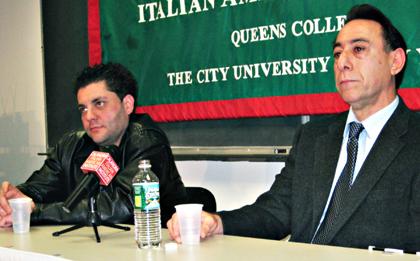By Anna Gustafson
When Johnny DeCarlo tried out for MTV’s reality show “Jersey Shore,” he did so because he wanted to portray Italian Americans in a positive light.
DeCarlo, 29, who spoke at an event sponsored by Queens College last week, had hoped to show the country his love of family, food, wine and travel. Instead, he never made it onto the program and “Jersey Shore” has become a pop culture phenomenon that has sparked controversy for what some say is yet another round of negative portrayals for an ethnic group frequently cast as mobsters or lower-class.
The eight members of “Jersey Shore” are shown spending much of their time preening, getting drunk and fighting — and they do so while calling themselves “guidos” and “guidettes,” terms that have been criticized by some who have labeled the words ethnic slurs used to put down Italian Americans.
Speaking at a conference on guidos at Queens College’s John D. Calandra Italian American Institute in Manhattan last Thursday, DeCarlo condemned what he said was an exploitation of Italian-American stereotypes by MTV, but defended the words guido and guidette, saying they can be a positive means of identification.
“Guido is about food, wine, cigars, coffee,” said DeCarlo, who frequently blogs about being Italian and owns a catering business in New Jersey.
DeCarlo joined state Sen. Diane Savino (D-Staten Island) and Queensborough Community College professor Donald Tricarico in last week’s colloquium entitled “Guido: An Italian American Youth Style,” which was held in response to the discussion “Jersey Shore” has prompted about Italian Americans.
“If you had asked me in 1981 to describe myself, I would’ve called myself a guidette,” Savino told the crowd gathered at the Italian American Institute in Manhattan. “What I found most interesting was the reaction to the term guido. Guido was never pejorative .%u2026 It was part of the social identification of young people.”
For Savino, guido or guidette was a way for Italian youth to reclaim a pride in their heritage.
“For those of us who were Italian Americans and who did not fit the standard of beauty in America in the 1970s — that Marcia Brady, long blond hair look — Guido was the way we could create our own standard of beauty.”
Instead of casting blame at the term guido as endorsed by Italian-American youth, Savino said it is time to pressure media outlets to change the way they are cast.
“The real enemy isn’t the stereotypes we made to make us feel comfortable, it’s that others have exploited it,” she said.
The problem, many of those at the event said, is the consistent barrage of negative portrayals of Italian Americans in the media.
“Why don’t we show a real Italian American family?” said Joseph Sciame, the national past president of the Order Sons of Italy in America and vice president for community relations at St. John’s University. “Why does it always have to be ‘The Godfather’ %u2026? Are there any shows on MTV that put down African Americans, Asian Americans the way they do with Italian Americans? Would those shows last more than a day?”
Tricarico, who has written numerous pieces about Italian-American culture, and specifically guidos and guidettes, agreed with DeCarlo and Savino. He described the term not as a slur but as a way to identify as a well-to-do young Italian American.
Guidos and guidettes, Tricarico said, are individuals who want to let it be known they have the time and money to spend on doing their hair and wearing nice clothes.
The terms were “used to battle a sense of inferiority” and distinguish themselves from their relatives growing up in the 1960s who were often working-class youth in Italian-American neighborhoods who had little money for “cultural consumption,” he said.
Reach reporter Anna Gustafson by e-mail at agustafson@cnglocal.com or by phone at 718-229-0300, Ext. 174.



































